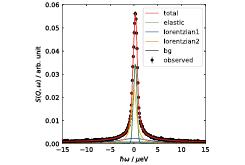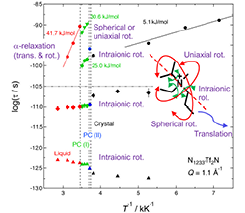Dynamics of Alkylammonium-Based Ionic Liquids with Plastic-crystalline Phases
Yamamuro Group
One of the characteristic and interesting features of ionic liquids (ILs) is nanometer-sized structure (nanostructure). For example, imidazolium-based ILs (ImILs) have nanostructures consisting of the polar-domains with imidazolium rings and anions and the non-polar domains with alkylchains of the cations. We have revealed that the nanostructure is essentially the same as that of a liquid-crystalline (LC) phase [1-3, 5] and investigated the dynamics of ImILs by means of quasielastic neutron scattering (QENS) [1, 2, 4, 5]. Recently, Yamada et al. found that some of alkylammonium-based salts, which are another popular ILs, have plastic-crystalline (PC) phases that are the counterparts to the LC phase; i.e., the LC phase has an orientationally-ordered positionally-disordered structure, while the PC phase has an orientationally-disordered positionally-ordered one.

Fig. 1. The experimental QENS spectrum (closed circles) of the PC1 phase of N1233’Tf2N obtained by HFBS. The result of the fitting, a fitted curve and each component, is also shown in the figure.

Fig. 2. Arrhenius plot of N1233’Tf2N and assignment of each relaxation mode. The structure of N1233’ cation and possible intraionic and overall motions are schematically shown in the inset.
We have measured the DSC, neutron diffraction (ND) and QENS data of methyldiethylisopropyl-ammonium bis (trifluoromethylsulfonyl)imide (abbreviated as N1223’Tf2N) and the methyl-ethylpropylisopropylammonium salt (N1233’Tf2N) in a temperature range between 4 and 400 K. The former cation is more spherical and non-chiral while the latter more ellipsoidal and chiral. The DSC and ND works revealed that both of two samples have, in the order of deceasing temperature, liquid (L), PC1, PC2 and crystalline (C) phases; PC1 may be a normal isotropic PC phase and PC2 an anisotropic PC phase where the cations undergo more restricted rotations. The QENS data were collected in a time range between 0.1 ps and 10 ns by means of HFBS and DCS spectrometers in NIST, USA.
As a representative result, Fig. 1 shows the QENS data for the PC1 phase of N1233’Tf2N which were obtained at 1.1 Å-1 and 280 K by using HFBS. The data for the PC and C phases were fitted to an elastic and two Lorentz functions, while those for the L phase to a KWW function. As shown in Fig. 1, the fittings were satisfactory for all Q and T data of both N1223’Tf2N and N1233’Tf2N. Figure 2 shows the Arrhenius plot of N1233’Tf2N. In a wide time-range covering 4 orders of magnitude, there are basically 4 relaxation modes in the PC phases and 3 modes in L and C phases. Faster two modes are almost continuous over whole temperature. By analyzing the Q-dependence of the relaxation times and elastic incoherent structure factors (EISF), the relaxation modes were assigned as shown in Fig. 2. The faster two (for the L phase) or three (for the PC and C phases) modes are clearly of intraionic rotations. The slowest mode in the PC phases is due to the spherical and/or uniaxial rotation. The slowest mode in the L phase is the α relaxation consisting of coupled overall rotational and translational motions. A similar mode assignment was performed for N1223’Tf2N. Thus, our QENS work has clarified how the intra- and overall ionic motions are activated through the sequential phase transitions (L-PC1-PC2-C).
References
- [1] O. Yamamuro et al., J. Chem. Phys. 135, 054508 (2011).
- [2] M. Kofu et al., J. Phys. Chem. B 117, 2773 (2013).
- [3] F. Nemoto et al., J. Phys. Chem. B 119, 5028 (2015).
- [4] M. Kofu et al., J. Chem. Phys. 143, 234502 (2015).
- [5] F. Nemoto et al., J. Chem. Phys., submitted.
